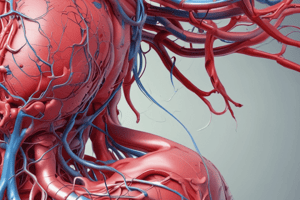Podcast
Questions and Answers
Which term refers to the area farthest from the central mass of a body?
Which term refers to the area farthest from the central mass of a body?
- Central
- Proximal
- Distal (correct)
- Peripheral
The term 'superior' refers to a location that is below another part of the body.
The term 'superior' refers to a location that is below another part of the body.
False (B)
What is the shortest axis that spans from the head to the tail called?
What is the shortest axis that spans from the head to the tail called?
Longitudinal or Anteroposterior
The area nearest to the surface is referred to as _____
The area nearest to the surface is referred to as _____
Match the following anatomical terms with their descriptions:
Match the following anatomical terms with their descriptions:
Which of the following describes a sagittal plane?
Which of the following describes a sagittal plane?
The median plane divides the body into equal left and right parts.
The median plane divides the body into equal left and right parts.
What term is used to refer to the side of the body facing the back?
What term is used to refer to the side of the body facing the back?
The __________ plane is perpendicular to both the sagittal and frontal planes.
The __________ plane is perpendicular to both the sagittal and frontal planes.
Match the terms with their correct definitions:
Match the terms with their correct definitions:
What is the function of the frontal plane?
What is the function of the frontal plane?
In bipeds, the transverse plane cuts vertically.
In bipeds, the transverse plane cuts vertically.
What is the opposite of the caudal end in anatomical terms?
What is the opposite of the caudal end in anatomical terms?
What does the term 'caudad' refer to?
What does the term 'caudad' refer to?
Cephalization refers to the decentralization of sense organs.
Cephalization refers to the decentralization of sense organs.
What term describes the structural similarity between different species due to a common ancestor?
What term describes the structural similarity between different species due to a common ancestor?
The types of symmetry present throughout the animal kingdom include spherical, radial, biradial, and __________.
The types of symmetry present throughout the animal kingdom include spherical, radial, biradial, and __________.
Match the following terms with their definitions:
Match the following terms with their definitions:
Bilaterally symmetrical animals have a median sagittal plane that serves as their plane of symmetry.
Bilaterally symmetrical animals have a median sagittal plane that serves as their plane of symmetry.
List one example of a consequence of body modification.
List one example of a consequence of body modification.
What is located ventrally in the hypobranchial groove?
What is located ventrally in the hypobranchial groove?
The tail of the organism is flattened and slimy.
The tail of the organism is flattened and slimy.
What type of epithelium is the epidermis made of?
What type of epithelium is the epidermis made of?
The _____ is a large bowl-shaped depression located ventrally.
The _____ is a large bowl-shaped depression located ventrally.
Match the following parts to their functions in the mentioned structure:
Match the following parts to their functions in the mentioned structure:
Which of the following statements about the gill slits is true?
Which of the following statements about the gill slits is true?
The eyes of the organism have eyelids.
The eyes of the organism have eyelids.
Where is the olfactory sac located?
Where is the olfactory sac located?
The _____ of the organism has many bumps and is supportive in structure.
The _____ of the organism has many bumps and is supportive in structure.
What distinguishes the appearance of mature male and female myotomes?
What distinguishes the appearance of mature male and female myotomes?
The liver is found on the left of the pharynx.
The liver is found on the left of the pharynx.
Identify the primary skeletal structure in the organism.
Identify the primary skeletal structure in the organism.
The _____ is the structure situated dorsal to the anterior notochord.
The _____ is the structure situated dorsal to the anterior notochord.
Match the anatomical features to their descriptions:
Match the anatomical features to their descriptions:
What function does the nictitating membrane serve?
What function does the nictitating membrane serve?
The head of the dogfish is described as rectangular in shape.
The head of the dogfish is described as rectangular in shape.
What is the pointed extremity found at the anterior tip of the dogfish called?
What is the pointed extremity found at the anterior tip of the dogfish called?
The chamber that receives contents from both the digestive and urogenital systems is called the ______.
The chamber that receives contents from both the digestive and urogenital systems is called the ______.
Which type of fin is located on the ventral side of the tail in smooth dogfish?
Which type of fin is located on the ventral side of the tail in smooth dogfish?
The paired lateral fins are located equidistant from the median lines of the animal.
The paired lateral fins are located equidistant from the median lines of the animal.
Name the two types of fins found in dogfish.
Name the two types of fins found in dogfish.
The whitish line that extends longitudinally across the sides of the dogfish's body is known as the ______.
The whitish line that extends longitudinally across the sides of the dogfish's body is known as the ______.
What connects the ears to the external environment?
What connects the ears to the external environment?
The dogfish has a dorsal fin without any spines.
The dogfish has a dorsal fin without any spines.
What is the primary function of the spiracle in dogfish?
What is the primary function of the spiracle in dogfish?
Which subclasses does Chondrichthyes include?
Which subclasses does Chondrichthyes include?
Skates belong to the order Rajiformes.
Skates belong to the order Rajiformes.
Which feature is present in Chondrichthyes but not in Osteichthyes?
Which feature is present in Chondrichthyes but not in Osteichthyes?
The nostrils of Chondrichthyes are dorsal and lack a fringed flap.
The nostrils of Chondrichthyes are dorsal and lack a fringed flap.
What are the gill slits of Chondrichthyes located on?
What are the gill slits of Chondrichthyes located on?
In Chondrichthyes, the eyes are located ______.
In Chondrichthyes, the eyes are located ______.
Match the following features with the respective groups:
Match the following features with the respective groups:
What is the primary shape of the body in Osteichthyes?
What is the primary shape of the body in Osteichthyes?
The mouth of Chondrichthyes is typically larger in females than in males.
The mouth of Chondrichthyes is typically larger in females than in males.
What structure covers the gill openings in Osteichthyes?
What structure covers the gill openings in Osteichthyes?
Gill rakers in Osteichthyes have a _______ shape.
Gill rakers in Osteichthyes have a _______ shape.
Match the fish classification with its characteristics:
Match the fish classification with its characteristics:
Which feature characterizes the caudal fin in Osteichthyes?
Which feature characterizes the caudal fin in Osteichthyes?
The oronasal groove in Chondrichthyes leads from the mouth to the internal nasal cavity.
The oronasal groove in Chondrichthyes leads from the mouth to the internal nasal cavity.
Describe the feature of lateral line in both groups of fish.
Describe the feature of lateral line in both groups of fish.
Chondrichthyes are primarily known for their __________ body structure.
Chondrichthyes are primarily known for their __________ body structure.
Match the scientific classification with their common names:
Match the scientific classification with their common names:
Flashcards
Dorsal
Dorsal
The side facing the back of an animal.
Ventral
Ventral
The side facing the belly of an animal.
Lateral
Lateral
The left and right sides of an animal.
Anterior
Anterior
Signup and view all the flashcards
Posterior
Posterior
Signup and view all the flashcards
Median
Median
Signup and view all the flashcards
Sagittal Plane
Sagittal Plane
Signup and view all the flashcards
Median Plane
Median Plane
Signup and view all the flashcards
Longitudinal Plane
Longitudinal Plane
Signup and view all the flashcards
Transverse Plane
Transverse Plane
Signup and view all the flashcards
Cephalic
Cephalic
Signup and view all the flashcards
Caudal
Caudal
Signup and view all the flashcards
Cephalization
Cephalization
Signup and view all the flashcards
Homologous Structures
Homologous Structures
Signup and view all the flashcards
Analogous Structures
Analogous Structures
Signup and view all the flashcards
Rostrum
Rostrum
Signup and view all the flashcards
Spiracle
Spiracle
Signup and view all the flashcards
Unpaired/Medial Fins
Unpaired/Medial Fins
Signup and view all the flashcards
Paired/Lateral Fins
Paired/Lateral Fins
Signup and view all the flashcards
Cloaca
Cloaca
Signup and view all the flashcards
Clasper
Clasper
Signup and view all the flashcards
Lateral Line
Lateral Line
Signup and view all the flashcards
Nictitating Membrane
Nictitating Membrane
Signup and view all the flashcards
Skate Skin
Skate Skin
Signup and view all the flashcards
Heterocercal Tail Fin
Heterocercal Tail Fin
Signup and view all the flashcards
Basal Plate
Basal Plate
Signup and view all the flashcards
Spine
Spine
Signup and view all the flashcards
Dorsoventrally Shortened
Dorsoventrally Shortened
Signup and view all the flashcards
Transversally Elongated
Transversally Elongated
Signup and view all the flashcards
Greatly Flattened Anterior
Greatly Flattened Anterior
Signup and view all the flashcards
Liver
Liver
Signup and view all the flashcards
Hypobranchial groove
Hypobranchial groove
Signup and view all the flashcards
Endostyle
Endostyle
Signup and view all the flashcards
Gonads
Gonads
Signup and view all the flashcards
Urogenital aperture
Urogenital aperture
Signup and view all the flashcards
Anal opening pit
Anal opening pit
Signup and view all the flashcards
Velum
Velum
Signup and view all the flashcards
Buccal cavity
Buccal cavity
Signup and view all the flashcards
Muscular tongue extensions
Muscular tongue extensions
Signup and view all the flashcards
Pericardial cavity
Pericardial cavity
Signup and view all the flashcards
Internal gill slits
Internal gill slits
Signup and view all the flashcards
Gill lamellae
Gill lamellae
Signup and view all the flashcards
Spinal cord
Spinal cord
Signup and view all the flashcards
Brain
Brain
Signup and view all the flashcards
Notochord
Notochord
Signup and view all the flashcards
Chimaeras/Ratfish
Chimaeras/Ratfish
Signup and view all the flashcards
Operculum
Operculum
Signup and view all the flashcards
Lateral Line System
Lateral Line System
Signup and view all the flashcards
Continuous Pectoral Fins
Continuous Pectoral Fins
Signup and view all the flashcards
Oronasal Groove
Oronasal Groove
Signup and view all the flashcards
Milkfish/Bangus (Chanos chanos)
Milkfish/Bangus (Chanos chanos)
Signup and view all the flashcards
Operculum/Gill Flap
Operculum/Gill Flap
Signup and view all the flashcards
Branchiostegal Membrane
Branchiostegal Membrane
Signup and view all the flashcards
Gill Rakers
Gill Rakers
Signup and view all the flashcards
Homocercal Tail Fin
Homocercal Tail Fin
Signup and view all the flashcards
Erectile Fin
Erectile Fin
Signup and view all the flashcards
Non-erectile Fin
Non-erectile Fin
Signup and view all the flashcards
Study Notes
LBYBIO 3-LE1 Study Notes
- Course section, schedule, and teacher details are listed.
- Links to related resources (Gizmo Deck, labeled images) are included.
- An overview with topics and subtopics is presented.
- Headings and subheadings organize the content.
- Figure and table references are given.
- Basic, bolded, italicized, underlined, and highlighted text are used.
- Bulleted lists and numbered lists present information.
- A sample passage of lorem ipsum text is included.
- A table with headers and subheaders is provided.
- A list of subject code and title is given.
Studying That Suits You
Use AI to generate personalized quizzes and flashcards to suit your learning preferences.



